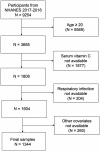The association between serum vitamin C levels and respiratory infections in children and adolescents
- PMID: 40538585
- PMCID: PMC12176603
- DOI: 10.3389/fnut.2025.1601218
The association between serum vitamin C levels and respiratory infections in children and adolescents
Abstract
Objective: Respiratory infections (RIs) are a leading cause of morbidity and mortality, and vitamin C may play a vital role in the risk of RIs. However, high-quality evidence on the association between vitamin C and RIs in the younger population remains limited. This study aimed to investigate the association between serum vitamin C and RI risk in a nationally representative sample of children and adolescents.
Methods: Utilizing data from the National Health and Nutrition Examination Survey (NHANES) 2017-2018, this study included 1,344 children and adolescents aged between 6 and 19 years old. Serum vitamin C levels were obtained from laboratory tests, and RIs were determined based on a self-reported health questionnaire. The association between vitamin C and RIs was tested using multivariable logistic regression models, interaction tests, and smoothing curve fitting.
Results: A total of 238 participants (17.7%) reported a respiratory infection in the past 30 days. Serum vitamin C was significantly and negatively associated with the risk of RIs in all regression models. After adjusting for all potential confounders, an increase of the vitamin C level by 10 units indicated a decrease of the RI risk by 7% (OR = 0.93, 95% confidence interval [CI]: 0.87, 0.99). Such an association remained consistently significant across subgroups with various demographical and health characteristics.
Conclusion: Our study shows a negative association between vitamin C and RIs among children and adolescents, highlighting the protective role of vitamin C against RIs. Our findings suggest that vitamin C supplementation may be potentially used for the prevention and treatment of RIs, which needs to be validated in future well-designed studies.
Keywords: NHANES5; adolescents; children; respiratory infection; vitamin C.
Copyright © 2025 Li, Zhu, Jiang, Feng, Gao, Li, Yang, Fang and Yang.
Conflict of interest statement
The authors declare that the research was conducted in the absence of any commercial or financial relationships that could be construed as a potential conflict of interest.
Figures


Similar articles
-
Effectiveness and safety of vitamin D in relation to bone health.Evid Rep Technol Assess (Full Rep). 2007 Aug;(158):1-235. Evid Rep Technol Assess (Full Rep). 2007. PMID: 18088161 Free PMC article.
-
Immunostimulants versus placebo for preventing exacerbations in adults with chronic bronchitis or chronic obstructive pulmonary disease.Cochrane Database Syst Rev. 2022 Nov 14;11(11):CD013343. doi: 10.1002/14651858.CD013343.pub2. Cochrane Database Syst Rev. 2022. PMID: 36373977 Free PMC article.
-
Systemic pharmacological treatments for chronic plaque psoriasis: a network meta-analysis.Cochrane Database Syst Rev. 2017 Dec 22;12(12):CD011535. doi: 10.1002/14651858.CD011535.pub2. Cochrane Database Syst Rev. 2017. Update in: Cochrane Database Syst Rev. 2020 Jan 9;1:CD011535. doi: 10.1002/14651858.CD011535.pub3. PMID: 29271481 Free PMC article. Updated.
-
Systemic pharmacological treatments for chronic plaque psoriasis: a network meta-analysis.Cochrane Database Syst Rev. 2021 Apr 19;4(4):CD011535. doi: 10.1002/14651858.CD011535.pub4. Cochrane Database Syst Rev. 2021. Update in: Cochrane Database Syst Rev. 2022 May 23;5:CD011535. doi: 10.1002/14651858.CD011535.pub5. PMID: 33871055 Free PMC article. Updated.
-
Heliox for croup in children.Cochrane Database Syst Rev. 2021 Aug 16;8(8):CD006822. doi: 10.1002/14651858.CD006822.pub6. Cochrane Database Syst Rev. 2021. PMID: 34397099 Free PMC article.
References
-
- Sirota SB, Doxey MC, Dominguez RMV, Bender RG, Vongpradith A, Albertson SB, et al. Global, regional, and national burden of upper respiratory infections and otitis media, 1990-2021: a systematic analysis from the global burden of disease study 2021. Lancet Infect Dis. (2025) 25:36–51. doi: 10.1016/S1473-3099(24)00430-4 - DOI - PMC - PubMed
-
- World Health Organization . Pneumonia in children. Available online at: https://www.who.int/news-room/fact-sheets/detail/pneumonia (Accessed March 19, 2025).
LinkOut - more resources
Full Text Sources
Miscellaneous

